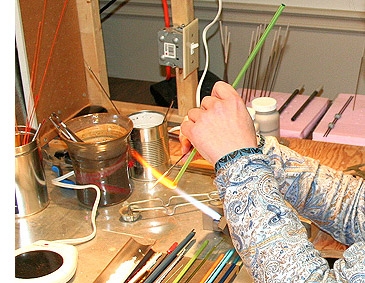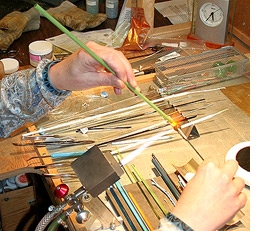 I have always loved bright, shiny things and as a child collected all sorts of pretty stones, shells, and beach glass. I still have many of those cherished objects.
I have always loved bright, shiny things and as a child collected all sorts of pretty stones, shells, and beach glass. I still have many of those cherished objects.
Beads have fascinated me for years and I have been embellishing clothing with them for a long time. I made my own wedding dress and beaded the bodice and sleeves in a vine and leaf pattern.
In my professional career as a dentist, I work with my hands every day but found that I needed a creative outlet. Jewelry making was a natural extension of this, requiring a degree of fine motor control and skill. My hobby has happily turned into a small business for me.
 I discovered lampworking, also known as flameworking, two years ago, and was hooked after I took my first course. My husband recognized this newfound passion in me and very kindly agreed to build a glass studio for me in our home.
I discovered lampworking, also known as flameworking, two years ago, and was hooked after I took my first course. My husband recognized this newfound passion in me and very kindly agreed to build a glass studio for me in our home.
Lampworking involves melting rods of different colored glass in the flame of a very hot (2000 degree) propane/oxygen torch, and winding the molten glass around a stainless steel rod (mandrel) which has been coated in a releasing agent…otherwise the glass will melt to the rod forever. When this happens it is known as a “pot sticker”. Glass rods get their color from various metal oxides, much like paint, but the colors don’t mix the way paint does…the reaction of the different metals within the glass can give rise to completely different effects at the edges where the colors meet. This can also be affected by the proportion of oxygen in relation to propane…an oxidizing flame or a reducing flame.
 Proper ventilation is crucial when working with glass; both the metal oxides and the fine particulate matter can be harmful. Special glasses are required to protect the eyes from the flare of the glass as it melts. Other safety equipment includes proper regulator valves for the controlled flow of propane and oxygen, high volume ventilation hood, fire extinguisher, smoke detector, and carbon monoxide detector.
Proper ventilation is crucial when working with glass; both the metal oxides and the fine particulate matter can be harmful. Special glasses are required to protect the eyes from the flare of the glass as it melts. Other safety equipment includes proper regulator valves for the controlled flow of propane and oxygen, high volume ventilation hood, fire extinguisher, smoke detector, and carbon monoxide detector.
After the bead is made, a process which can take from a few minutes to over an hour for a single bead, the mandrel and bead are placed in a hot kiln (approximately 1000 degrees) to “soak” for a period of time, then very slowly cooled over a period of many hours, to relieve the stress in the glass. This process is called annealing, and is a critical part of lampworking. Without being annealed the glass will be prone to cracking, shortly after being made or many months in the future. When buying lampwork beads, be sure to ask if the beads have been properly kiln-annealed. Inexpensive, commercial, or mass produced beads often are not, and will be prone to cracking.
 Lampworking has given me more freedom and flexibility in my jewelry designing than I ever thought possible….colors, patterns, and shapes can be created for custom designs, as focal pieces, or accents.
Lampworking has given me more freedom and flexibility in my jewelry designing than I ever thought possible….colors, patterns, and shapes can be created for custom designs, as focal pieces, or accents.
As much as I love designing jewelry with my own lampwork beads, I also love to see what other jewelry designers create with the beads I sell as components. iCraft has so many talented jewelry artisans and I would encourage everyone to check out this section if you haven’t already.
Footnotes: All photos for this article were provided by Gillian Soskin ©2009. Visit Gillian's Creator Exhibit Brilliant Beads. See other "Lampwork" products on iCraftGifts.com.
- Category:
- Tips, Tutorials & DIYs
- All Things Crafts
- Tags:
- beads
- DIY
- beading
- lesson
- lampworking
- jewelry making














